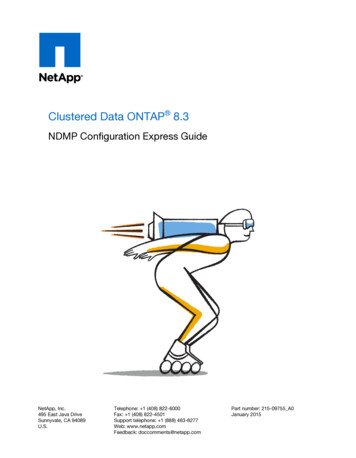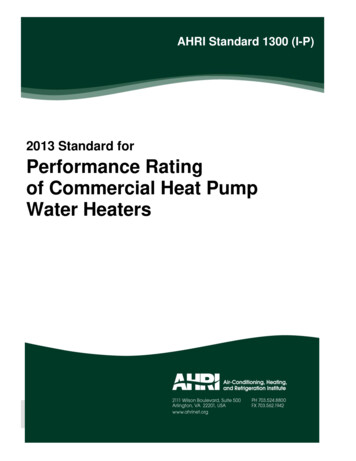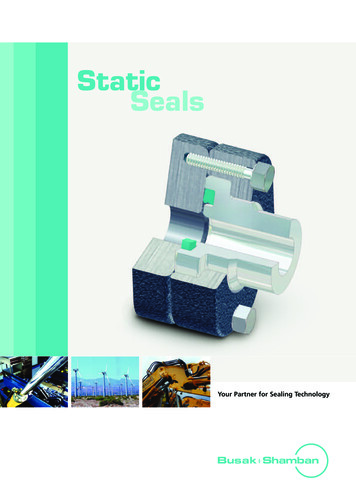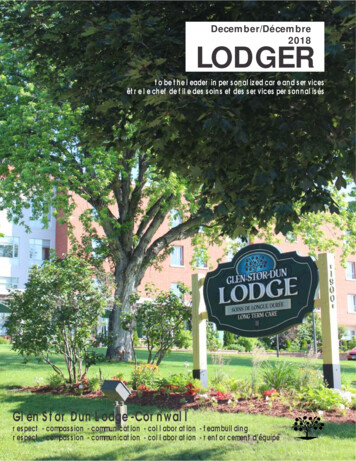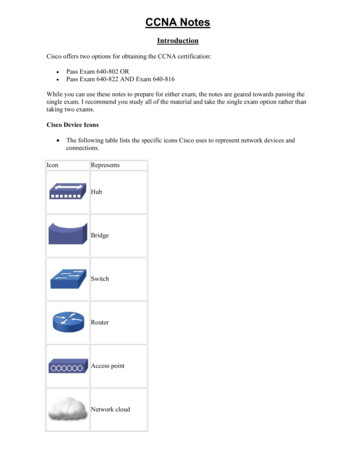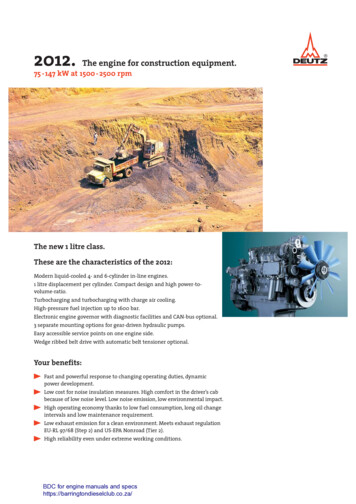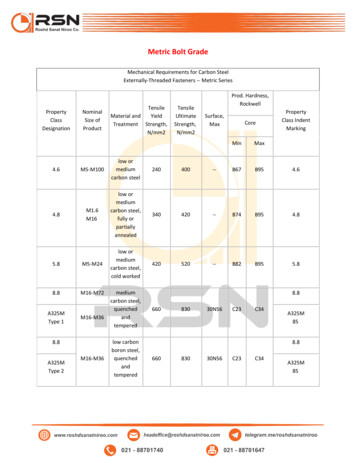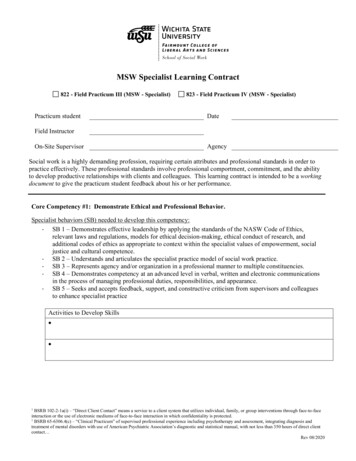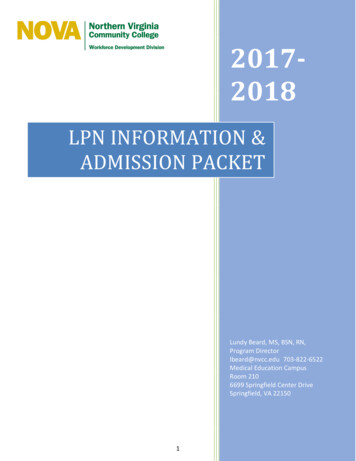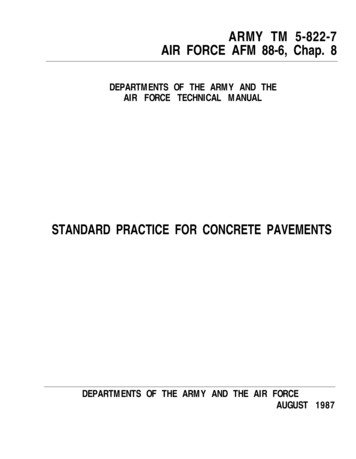
Transcription
ARMY TM 5-822-7AIR FORCE AFM 88-6, Chap. 8DEPARTMENTS OF THE ARMY AND THEAIR FORCE TECHNICAL MANUALSTANDARD PRACTICE FOR CONCRETE PAVEMENTSDEPARTMENTS OF THE ARMY AND THE AIR FORCEAUGUST 1987
REPRODUCTIONAUTHORIZATION/RESTRICTIONS
TECHNICAL MANUALNo. 5-822-7AIR FORCE MANUALNo. 88-6, Chapter 8HEADQUARTERSDEPARTMENTS OF THE ARMYAND THE AIR FORCEWashington, DC 16 August 1987STANDARD PRACTICE FOR CONCRETE PAVEMENTSParagraph PagePURPOSE . . . . . . . . . . . . . . . . . . . . . . . . . . . . . . . . . . . . . . . . . . . . . . . . . . . . . . . . . . . . . . . . . . . . . . . . . . . . . . . . . . . . . . . . . . . . . . . . . . . . . . . . . . . . . . . . . . . . . . . . . . . . . . .SCOPE . . . . . . . . . . . . . . . . . . . . . . . . . . . . . . . . . . . . . . . . . . . . . . . . . . . . . . . . . . . . . . . . . . . . . . . . . . . . . . . . . . . . . . . . . . . . . . . . . . . . . . . . . . . . . . . . . . .RESPONSIBILITIES, STRENGTH, AND AIR CONTENT . . . . . . . . . . . . . . . . . . . . . . . . . . . . . . . . . . . . . . . . . . . . . . . . . . . . . . . . . . . . . . . . . . . . . . . . . . . . . . . . . . . . . . . . .CEMENT . . . . . . . . . . . . . . . . . . . . . . . . . . . . . . . . . . . . . . . . . . . . . . . . . . . . . . . . . . . . . . . . . . . . . . . . . . . . . . . . . . . . . . . . . . . . . . . . . . . . . . . . . . . . . . . . . . . . . . . . . . . . . . . .AGGREGATES . . . . . . . . . . . . . . . . . . . . . . . . . . . . . . . . . . . . . . . . . . . . . . . . . . . . . . . . . . . . . . . . . . . . . . . . . . . . . . . . . . . . . . . . . . . . . . . . . . . . . . . . . . . . . . . . . . . . . . . . . . . . .ADMIXTURES . . . . . . . . . . . . . . . . . . . . . . . . . . . . . . . . . . . . . . . . . . . . . . . . . . . . . . . . . . . . . . . . . . . . . . . . . . . . . . . . . . . . . . . . . . . . . . . . . . . . . . . . . . . . . . . . . . . . . . .POZZOLANS . . . . . . . . . . . . . . . . . . . . . . . . . . . . . . . . . . . . . . . . . . . . . . . . . . . . . . . . . . . . . . . . . . . . . . . . . . . . . . . . . . . . . . . . . . . . . . . . . . . . . . . . . . . . . . . . . . . . . . . . . . . . . .MISCELLANEOUS MATERIALS . . . . . . . . . . . . . . . . . . . . . . . . . . . . . . . . . . . . . . . . . . . . . . . . . . . . . . . . . . . . . . . . . . . . . . . . . . . . . . . . . . . . . . . . . . . . . . . . . . . . . . . . . . . . . . . . . . . . . . . . . . . . . . .WATER . . . . . . . . . . . . . . . . . . . . . . . . . . . . . . . . . . . . . . . . . . . . . . . . . . . . . . . . . . . . . . . . . . . . . . . . . . . . . . . . . . . . . . . . . . . . . . . . . . . . . . . . . . . . . . . . . . .SAMPLING AND TESTING OF MATERIALS . . . . . . . . . . . . . . . . . . . . . . . . . . . . . . . . . . . . . . . . . . . . . . . . . . . . . . . . . . . . . . . . . . . . . . . . . . . . . . . . . . . . . . . . . . . . . . . . . . . . . . . . . . . . . . .DELIVERY AND STORAGE OF MATERIALS . . . . . . . . . . . . . . . . . . . . . . . . . . . . . . . . . . . . . . . . . . . . . . . . . . . . . . . . . . . . . . . . . . . . . . . . . . . . . . . . . . . . . . . . . . . . . . . . . . . . . .GRADE CONTROL . . . . . . . . . . . . . . . . . . . . . . . . . . . . . . . . . . . . . . . . . . . . . . . . . . . . . . . . . . . . . . . . . . . . . . . . . . . . . . . . . . . . . . . . . . . . . . . . . . . . . . . . . . . . . . . . . . . . .PROPORTIONING . . . . . . . . . . . . . . . . . . . . . . . . . . . . . . . . . . . . . . . . . . . . . . . . . . . . . . . . . . . . . . . . . . . . . . . . . . . . . . . . . . . . . . . . . . . . . . . . . . . . . . . . . . . . . . . . . . . . . . . . .SUBGRADE, BASE, FORMS, AND STRING LINES . . . . . . . . . . . . . . . . . . . . . . . . . . . . . . . . . . . . . . . . . . . . . . . . . . . . . . . . . . . . . . . . . . . . . . . . . . . . . . . . . . . . . . . . . . . . . . . . . . . . .BATCHING AND MIXING . . . . . . . . . . . . . . . . . . . . . . . . . . . . . . . . . . . . . . . . . . . . . . . . . . . . . . . . . . . . . . . . . . . . . . . . . . . . . . . . . . . . . . . . . . . . . . . . . . . . . . . . . . . . . . . . . . .PLACING . . . . . . . . . . . . . . . . . . . . . . . . . . . . . . . . . . . . . . . . . . . . . . . . . . . . . . . . . . . . . . . . . . . . . . . . . . . . . . . . . . . . . . . . . . . . . . . . . . . . . . . . . . . . . . . . . . . . . . . . .FIELD TEST SPECIMENS . . . . . . . . . . . . . . . . . . . . . . . . . . . . . . . . . . . . . . . . . . . . . . . . . . . . . . . . . . . . . . . . . . . . . . . . . . . . . . . . . . . . . . . . . . . . . . . . . . . . . . . . . . . . . . . . . . .FINISHING . . . . . . . . . . . . . . . . . . . . . . . . . . . . . . . . . . . . . . . . . . . . . . . . . . . . . . . . . . . . . . . . . . . . . . . . . . . . . . . . . . . . . . . . . . . . . . . . . . . . . . . . . . . . . . . . . . . . . . . . . . . . . . . .CURING . . . . . . . . . . . . . . . . . . . . . . . . . . . . . . . . . . . . . . . . . . . . . . . . . . . . . . . . . . . . . . . . . . . . . . . . . . . . . . . . . . . . . . . . . . . . . . . . . . . . . . . . . . . . . . . . . . . . . . . . . . . . . . .GRADE AND SURFACE -SMOOTHNESS REQUIREMENTS . . . . . . . . . . . . . . . . . . . . . . . . . . . . . . . . . . . . . . . . . . . . . . . . . . . . . . . . . . . . . . . . . . . . . . . . . . . . . . . . . . . . .TOLERANCES IN PAVEMENT THICKNESS . . . . . . . . . . . . . . . . . . . . . . . . . . . . . . . . . . . . . . . . . . . . . . . . . . . . . . . . . . . . . . . . . . . . . . . . . . . . . . . . . . . . . . . . . . . . . . . . . . . . . . . . . . . . . . . .REPAIRS OF DEFECTIVE PAVEMENT SLABS . . . . . . . . . . . . . . . . . . . . . . . . . . . . . . . . . . . . . . . . . . . . . . . . . . . . . . . . . . . . . . . . . . . . . . . . . . . . . . . . . . . . . . . . . . . . . . . . . . . . . . . . . . .JOINTS . . . . . . . . . . . . . . . . . . . . . . . . . . . . . . . . . . . . . . . . . . . . . . . . . . . . . . . . . . . . . . . . . . . . . . . . . . . . . . . . . . . . . . . . . . . . . . . . . . . . . . . . . . . . . . . . . . . . . . . . . . . . . .PAVEMENT PROTECTION . . . . . . . . . . . . . . . . . . . . . . . . . . . . . . . . . . . . . . . . . . . . . . . . . . . . . . . . . . . . . . . . . . . . . . . . . . . . . . . . . . . . . . . . . . . . . . . . . . . . . . . . . . . . . . . . . .MEASUREMENTS . . . . . . . . . . . . . . . . . . . . . . . . . . . . . . . . . . . . . . . . . . . . . . . . . . . . . . . . . . . . . . . . . . . . . . . . . . . . . . . . . . . . . . . . . . . . . . . . . . . . . . . . . . . . . . . . . . . . . . .APPENDIX A: REFERENCES . . . . . . . . . . . . . . . . . . . . . . . . . . . . . . . . . . . . . . . . . . . . . . . . . . . . . . . . . . . . . . . . . . . . . . . . . . . . . . . . . . . . . . . . . . . . . . . . . . . . . . . . . . . . . . . . . . . . . . . . . . . . . . .APPENDIXB:THIN BONDED RIGID OVERLAYS FOR RIGID PAVEMENTS . . . . . . . . . . . . . . . . . . . . . . . . . . . . . . . . . . . . . . . . . . . . . . . . . .APPENDIX C: STEEL-FIBER- REINFORCED CONCRETE . . . . . . . . . . . . . . . . . . . . . . . . . . . . . . . . . . . . . . . . . . . . . . . . . . . . . . . . . . . . . . . . . . . . . . . . . . . . . . . . . . . . .APPENDIX D: ROLLER-COMPACTED CONCRETE PAVEMENTS; DESIGN AND -1B-1C-1D-1i
LIST OF FIGURESFigure 1.2.3.D-1.D-2.D-3.D-4.D-5.Prediction of concrete rate of evaporation.Air Force runway grooving requirements.Special joint between new and existing pavement.Typical layout for RCCP test section.Compaction of first paving lane.Compaction of interior paving lanes.Construction of a cold joint.Two-lift cold joint preparation.LIST OF TABLESTable 1.2.3.4.5.6.7.8.C-1.C-2.D-1.Approximate relation between water-cement ratio and strengths of concreteCoarse aggregate size groupsGrading of coarse aggregateDeleterious materials in coarse aggregates for airfield and heliport pavementsDeleterious materials in coarse aggregates for other pavementsGrading of fine aggregateDeleterious substances in fine aggregateSurface smoothness - airfield and heliport pavementsSelected characteristics of fiber-reinforced airfield pavementsInterim suggested maximum joint spacing for steel-fiber-reinforced concreteVibratory rollers used in RCCP construction
STANDARD PRACTICE FOR CONCRETE PAVEMENTS1. Purpose. This manual provides information on thematerials and construction procedures for concretepavements.2. Scope. This manual describes the constituents tobe used in concrete, the procedures to be used inmanufacturing concrete, and the equipment andprocedures to place, texture, and cure concrete forpavements.3. Responsibilities, strength, and air content.a. Responsibility for mixture proportioning. Theresponsibility for mixture proportioning must beclearly assigned to either the contractor or thecontracting officer in the project specifications.When the contracting officer is responsible formixture proportioning, he will approve all concretematerials as well as determine and adjust proportions of all concrete mixtures as necessary to obtainthe strength and quality of concrete required for thepavements. Cement will be a separate pay item inthe contract. When the contractor is responsible formixture proportioning, he will control all proportionsof the concrete mixture necessary to obtain thestrength and quality of the concrete required for thepavements, and cement will not be a separate payitem in the contract. However, the contracting officeris responsible for approving the quality of allmaterials the contractor uses in the concrete.b. Approval responsibility. The contracting officeris responsible for approval of all materials, mixtureproportions, plants, construction equipment, andconstruction procedures proposed for use by thecontractor. The contractor must submit proposedmixtures if he is responsible for mixture proportioning; samples of all materials; and detaileddescriptions of all plants, construction equipment,and proposed construction procedures prior to thestart of construction.c. Flexural strength. Structural designs are basedon flexural strengths that the concrete is expectedto obtain at 28 days for road pavements and 90 daysfor airfield pavements. These ages are not adequatefor quality control in the field since a large amountof low-strength concrete could be placed beforestrength tests on samples revealed the problem.Correlations can be established between a 14-daystrength and the 28- or 90–day strength used indesign, and this correlated 14-day strength can beused as a strength check for a more timely concretemixture control in the field.(l.) Materials and flexural strength. To selectsuitable flexural strengths for the design ofpavements and for inclusion in contract specifications, the contracting officer should have reliableinformation regarding flexural strengths obtainablewith acceptable concrete materials which are availablein the vicinity of the project. Typical design valuesfor flexural strength of paving-quality concretevary from 500 to 750 pounds per square inch (psi).Numerous tests indicate considerable variation inthe flexural strength of concrete when differentaggregates or different cements are used. There aresome indications that aggregate shape and modulusof elasticity are relatively more important inconcrete flexural strength than in compressivestrength. Also, after optimum flexural strength isreached, there usually is little increase in strength,even with a large increase in cement content. Mixtureproportioning studies will be made in accordancewith ACI 211.1 (see app A for referenced publications)to determine the flexural strengths to be used forthe design of the project. The water-cement ratiostrength relations for mixture proportioning in ACI211.1 are given in terms of compressive strength.Table 1 gives some approximate guidance forrelating the concrete modulus of rupture to thecompressive strength-water cement ratio relationships given in ACI 211.1. All aggregates, cementitiousmaterials, and admixtures used in the mixtureproportioning studies will be representative ofmaterials available for use in pavement construction.In selecting a flexural strength for pavement design,suitable allowance will be made for variations instrength indicated by tests of different combinations of aggregate and cement. Pavement designwill be based on a realistic and economical strengthobtainable with available materials.1
Table 1. Approximate relation between water-cement ratio and strengths of concrete (modified from ACI 211.1)(eq 1)
TM 5-822-7/AFM 88-6, Chap. 8characteristics of freshly mixed concrete and isrequired for the freezing and thawing resistance ofhardened concrete. The use of entrained air inconcrete will reduce strength, but because of theimproved workability in the freshly mixed concrete,adjustments in aggregate proportions and reductionof water are normally possible that will negate or atleast minimize the loss of strength. Proper proportioning and control of the air-entrained concretemixture are essential in order to derive maximumbenefits from improvement in the placability anddurability of concrete with a minimum effect onflexural strength.(2.) Percentage of air content. The specified aircontent will be 6 1½ percent for concretepavements located in regions where resistance tofreezing and thawing is a prime consideration, andwill be 5 1½ percent for concrete pavementslocated in regions where frost action is not a factorand air entrainment is used primarily to improve theworkability and placability of freshly mixed concrete.Air content will be controlled in the field at the pointwithin the specified range most appropriate for localconditions depending upon the severity of exposureand the quality and maximum size of aggregate. Ifslag aggregate is used, the air content will be determined by the volumetric method as described inASTM C 173. Where the aggregate is of comparatively poor quality or when the maximum size is 1%inches or less, the air content will be controlled at 6 1 percent. In such instances, where resistance tofreezing and thawing is not a prime consideration,the air content will be 5 1 percent. If furtherreduction in the air content or the use of non-airentrained concrete is necessary, prior approval willbe obtained from HQDA (DAEN-ECE-G), Washington, DC 20314-1000 or the appropriate Air Forcemajor command.e. Cement content. Either the contractor or thecontracting officer may be responsible for mixtureproportioning. When the contractor is responsiblefor mixture proportioning, no separate payment willbe made for cement. When the contracting officer isresponsible for mixture proportioning, no limits forthe quantity of cement content will be included inthe contract specifications; the quantity of cementused per cubic yard of concrete will be determinedby the contracting officer, and cement will be paidfor under a separate bid item. When the concreteproposed for use on a paving project has a cementcontent of less than 470 pounds per cubic yard, priorapproval will be obtained from HQDA (DAEN-ECE-G) or the appropriate Air Force major command.When concrete proportioning is the responsibility ofthe contractor and the cement content is less than470 pounds per cubic yard, the results should beverified by two Corps of Engineers Divisionlaboratories or commercial laboratories prior tosubmittal. The results of mixture proportioningstudies for proposed aggregates and cements andthe results of qualitative tests on aggregates and onresulting concretes will be submitted with requestsfor approval.4. Cement.a. Five portland cements designated as Types Ithrough V are marketed today. ASTM C 150 providesa detailed specification for these cements. Type Iportland cement is common or ordinary cement thatis supplied unless another type is specified. Type IIis modified portland cement that provides moderateresistance against sulfate attack and a lower heat ofhydration than Type I cement. It is common forcement to be manufactured to meet the physical andchemical requirements of both Type I and II cements.b. Type III cement is high early-strength cement.Ultimate strength is about the same as Type Icement, but Type III cement has a 3-day compressivestrength approximately equal to the Type Icement’s 7-day strength. The cost of Type IIIcement in lieu of Types I or II cement can only bejustified when early strength gain is needed to openpavements to traffic or the high heat of hydration isneeded for cool construction periods. Type IVcement has a low heat of hydration that may beuseful in mass concrete but is not likely to beencountered in pavement construction. Type Vsulfate-resistant cement should be used when theconcrete will be exposed to severe sulfate attack.The potential for severe sulfate attack exists whenthe concrete is exposed to water-soluble sulfate insoil or water in excess of 0.20 percent or 1,500 partsper million. The potential for moderate sulfateattack exists for sulfate contents in excess of 0.10,or 150 parts per million.c. High alumina cement, also known as aluminousor calcium aluminate cement, gains most of itsstrength in one day, has a high exotherm, is resistantto chemical attack, and is a refractory material.When exposed to warm, moist conditions, it willundergo a long-term strength loss. High aluminacement may find some specialized applications inpavement construction where its rapid strengthgain, high exotherm, or refractory properties3
TM 5-822-7/AFM 88-6, Chap. 8outweigh its cost and long-term strength loss.d. There are also some expansive cements,designated as Types K, M, and S in ASTM C 845,that may find some application where concreteshrinkage needs to be minimized or avoided.However, there is little experience with thesecements, and they will require careful investigationbefore use in pavement construction.e. At least one United States manufacturer isactively promoting a slag cement made by grindingiron blast furnace slag. This may be substituted forup to 50 percent of the portland cement in a pavementmixture if tests show the required final propertiesare achieved in the hardened concrete. Preblendedmixes of portland-pozzolan (Type IP), and portlandslag cements (Type IS) are described in ASTM C 595and are acceptable for use in pavements.5. Aggregates.a. Approval of aggregates. The contractor will useaggregates from approved sources. If the contractorproposes to use aggregates from an unapprovedsource, the Government will be responsible forconducting tests to determine whether the proposedaggregates will meet the requirements of the project.Sampling and aggregate delivery costs will be borneby the contractor. The contract specifications willstate aggregate sample size, delivery location, andrequired evaluation time for the proposed aggregates. For small jobs requiring 1,600 cubic yards orless of concrete, all tests for aggregates from anunapproved source will be done by the contractor.b. Quality. Aggregates must generally meet therequirements of ASTM C 33, as modified in thefollowing paragraphs. These requirements can beadjusted as necessary to reflect local experiencewith specific aggregates to insure economical use ofaggregates to meet project requirements. Themagnesium or sulfate soundness test (ASTM C 88)required in ASTM C 33 has not been consistentlysuccessful in identifying frost-resistant aggregate.Consequently, if an otherwise suitable aggregatefails this test, it should be further investigatedusing freezing and thawing tests as described inASTM C 666 or ASTM C 682 before it is finallyrejected. Similarly, if an otherwise suitable aggregate fails the Los Angeles (LA) abrasion test(ASTM C 131 or C 535), it can be accepted if it has ahistory of local use showing that it can be processedwithout unacceptable degradation and that it isdurable under weathering and traffic conditions4comparable to the project under investigation.c. Recycled concrete as aggregate. Existingconcrete may be taken up, crushed to suitablegradation, and re-used as concrete aggregate. Itmust meet all the requirements for gradation andquality that conventional aggregates must meet.All reinforcing steel should be removed. Duringcrushing, hammermill secondary crushers tend toproduce excess fines and should not be used. Therecycled concrete aggregates will not normallyrequire washing unless they have been contaminatedwith base or subgrade material. If the original pavement that is being recycled is D-cracked, then theconcrete should be crushed to a maximum size of ¾inch. When crushed concrete is being used as fineaggregate, the inclusion of some natural sand maybe required to improve the new concrete mixture’sworkability.d. Alkali-aggregate reactions. Minerals in someaggregates can chemically react with the cementalkalis, resulting in an increase in volume thatplaces the concrete under expansive stresses whichmay result in map cracking, popouts, strength loss,and concrete expansion. Once started, the reactionand the resulting progressive deterioration of theconcrete cannot be stopped. These reactions aregenerally associated with aggregates containingpoorly ordered forms of silica, such as opal,chalcedony, chert, or flint (alkali-silica reaction),complex layer-lattice, and silicate minerals such asgraywackes, phyllites, siltstones, or argillites (sometimes differentiated as alkali-silicate reaction), orargillaceous, dolomitic limestone (alakali-carbonatereaction). A petrographic investigation in conjunctionwith results of tests in accordance with ASTM C 227for alkali-silica expansion and ASTM C 586 foralkali-carbonate expansion is the most promisingapproach for identifying these problems. If possible,reactive aggregates should be avoided. If they cannotbe avoided, low-alkali cement should be specified. Iflow-alkali cement is not available or is overly expensive, some pozzolans and slag cements have beensuccessful in countering alkali-silica reactions, orreactive aggregate may be blended with non-reactiveaggregate to lessen the effect of the reactions.e. Coarse aggregate.(l.) Composition. Coarse aggregate may benatural gravel, crushed gravel, crushed stone, crushedrecycled concrete, or iron blast furnace slag. Thecrushing of gravel tends to improve the quality andthe bond characteristics and generally results in ahigher flexural strength of concrete than if uncrushed
TM 5-822-7/AFM 88-6, Chap. 8gravel is used. When mixture proportioning studiesor local experience indicates that a low flexuralstrength will be obtained with uncrushed gravel, thepossibility of obtaining higher strength by crushingthe gravel will be investigated. Elongated particleswith a width–to-thickness ratio in excess of 3 maynot exceed 20 percent by weight as determined byCRD-C 119. This requirement attempts to avoidintroducing structural planes of weakness in thefinished concrete, workability problems associatedwith an excess of particles of these shapes, anddurability problems that may develop if air andwater are trapped under flat and elongated particles.(2.) Size and grading. The maximum size of thecoarse aggregate used in pavement concrete shouldnot exceed one-fourth of the pavement thickness. Inno case will the coarse aggregate exceed a 2-inchmaximum size. However, for pavement constructionin areas where aggregate popouts have been a problemor may occur, the coarse aggregate will not exceed1½-inch nominal maximum size. In areas where“D” line cracking in pavements has been a problem,limestone aggregates should not exceed ½-inchnominal maximum size and should be of low absorption. When the nominal maximum size of coarseaggregate is greater than 1 inch, the aggregatesshall be furnished in two size groups as shown intable 2, with gradings within the separated sizegroups conforming to the requirements of table 3.Where local practice provides size-group separationsother than as shown in table 2, local size gradingsmay be specified if approximately the same sizeranges are obtained and the grading of coarse aggregate when combined and batched for concrete is asrequired by mixture proportioning. For projectsrequiring 1,600 cubic yards or less of concrete,special grading requirements for coarse aggregateaccording to local practice may be substituted forthe gradings shown. Local State Department ofTransportation specifications for gradings may beused for those jobs requiring 1,600 cubic yards orless of concrete.Table 2. Coarse aggregate size groupsLNominal Maximum SizeSize Groups1½ in.No. 4 to ¾ in.¾ in. to 1½ in.2 in.No. 4 to 1 in.1 in. to 2 in.5
TM 5-822-7/AFM 88-6, Chap. 8Table 3. Grading of coarse aggregateSieve SizeU. S. StandardSquare Mesh2-1/2Percentage by Weight Passing Individual SievesNo. 4 toNo. 4 to3/4 in. to1 in. to3/4 in.1 in.1-1/2 in.2 in.in.2 in.- -- -- -- -1-1/2 in.1 in.3/4 in.1/2in.9 5 57 7- -- -- - -3 3- -No. 4- -- -No. 8- -- -(3.) Deleterious substances.(a) Pavements used by aircraft. Table 4 liststhe common deleterious substances and specifieslimits for these materials. The performance historyof local aggregates contributing to pavementdefects will be the determining factor in setting thelimits for deleterious substances. The limits areintended to eliminate popouts and weatherouts inairfield pavements. Other deleterious substancesknown to contribute to popouts will be identified bythe contracting officer, and suitable limits will bespecified. Calcium oxide (CaO) and magnesium oxide(MgO) or a mixture thereof, in lumps, representingthe hard burned oxides from fluxing stone or refractory brick should be added to the list of deleterioussubstances if air-cooled blast furnace slag is used asthe aggregate. Since the types of materials producingpopouts will vary for different areas, some adjustments of the limits may be desirable for individualprojects. Reductions in specified limits may bemade as necessary, but increases to permit the useof local aggregates that have an acceptable experiencerecord will be governed by the following procedures.Air Force Regional Civil Engineers (AFRCE) havebeen authorized to instruct division engineers to350 ’209 7 310010097 1001003/8 in.6- -waive table 4 requirements for Air Force pavements.Upon request, the AFRCE and the using commandwill be furnished available engineering informationon local aggregates and behavior records on pavements made from them. A copy of the instructionsand the revised requirements will be furnished forinformation to the HQDA (DAEN-ECE-G) orAFESC as applicable. In the case of Air NationalGuard and Army pavements, the using commandwill be furnished information on the costs of aggregates complying with specification requirementsand on less costly local aggregates along withbehavior records on pavements made with localaggregates. However, requirements will be waivedonly if requested by the Air National Guard BaseDetachment Commander or the Army InstallationCommander with his assurance that operationalrequirements will be satisfied by a performance thatis equal to that of existing pavements constructedwith these less costly aggregates. Requests will besubmitted for approval to HQDA (DAEN-ECE -G)with proposed specification requirements, comparative cost estimates, and evidence that operationalrequirements will be satisfied.
TM 5-822-7/AFM 88-6, Chap. 8Table 4. Deleterious materials in coarse aggregates for airfield and heliport pavements.Areas withMinor PopoutsAreas withMajor PopoutsaaSevere aWeatherModerateWeatherClay lumps0.20.22.02.0Shale b0.10.21.01.0Material finerthan No. 200 1.0MaterialsparticlesClay Severe, moderate, and mild weather are defined as follows:WeatherSeverityAir Freezing Indexfor ColdestYear in 30*Average Precipitation for a SingleMonth During Period--1 Month BeforeAverage Date of First Killing Frostto Average Date of Last Killing FrostModerate500 or lessAny amountModerate**501 or moreLess than 1 inchSevere501 or more1 inch or more* Calculated as described in TM 5-818-2/AFM 88-6, Chapter 4.** In poorly drained areas, the weather should be considered severeeven though the other criteria indicate a rating of moderate.bShale is defined as a fine-grained thinly laminated or fissile sedimentary rock.It is commonly composed of clay or silt or both. It has been indurated by compaction or by cementation, but not so much as to have become slate.cLimit for material finer than No. 200 sieve will be increased to 1.5 percent forcrushed aggregates if the fine material consists of crusher dust that is essentially free from clay or shale.dThe separation medium shall have a specific gravity of 2.0. This limit does notapply to coarse aggregate manufactured from blast-furnace slag unless contaminationis evident.eClay ironstone is defined as an impure variety of iron carbonate, iron oxide,hydrous iron oxide, or combinations thereof, commonly mixed with clay, silt, orsand. It commonly occurs as dull, earthy particles, homogeneous concretionarymasses, or hard shell particles with soft interiors. Other names commonly used forclay ironstone are “chocolate bars” and limonite concretions.7
TM 5-822-7/AFM88-6, Chap. 8Areas withMinor PopoutsAreas withMajor Claystone, mudstone,and/or siltstone 01.02.01.02.03.05.0MaterialsChert and/or chertystone (less thanSevereWeatherModerateWeathera2.50 sp. gr. SSD) fargillahceous limestoneparticlesTotal of all deleterious substancesexclusive of material finer thanNo. 200 sievefChert is defined as rock composed of quartz, chalcedony, or opal, or any mixtureThe texture is so fine thatIt is variable in color.of these forms of silica.the individual mineral
STANDARD PRACTICE FOR CONCRETE PAVEMENTS 1. Purpose. This manual provides information on the materials and construction procedures for concrete pavements. 2. Scope. This manual describes the constituents to be used in concrete, the procedures to be used in manufacturing concrete, and the
